Testimonies
Here is a selection of testimonies submitted to us via e-mail or Facebook, and originally published on our Hungarian-language website. These testimonies were selected and, unless stated otherwise, translated into English by Gwen Jones. To submit a story, please write to bertalan@ceu.edu.
2014. July 14., Monday
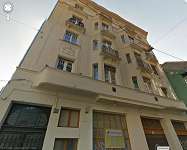
I grew up here and didn’t know anything [about the yellow-star houses in 1944] which, since I was born in 1965, is no wonder. Everyone was silent, even the Jewish lady who lived above us, who could have told us everything! We got on well with her, and everyone else too. In the 1970s, the house was full of musicians and singers! If the name Sissy means something to anyone, I’d appreciate it! “I’d sooner say my weight than my age,” she used to say.
She played the piano… it was lovely. In 1945, she took a lady in for a few days who was waiting for her son to return home, and the lady still lived here in the 1970s when she died.
I grew up with the sound of people practicing music and songs, and in the fear of silence. The Jewish lady above us was silent, just like my own grandfather was silent about his ten years in a Siberian prison, just like my mother was silent about post-war nationalization: everyone remained silent about what they should have shouted themselves hoarse about! To shout against inhumanity! I didn’t know this at the time, but I do now: this was the silence of fear!
I hope that there won’t be another decade like that one in the history of humanity!
Well, that was my yellow-star house story.
Respectfully, Zoltán Nyul.
2014. July 09., Wednesday
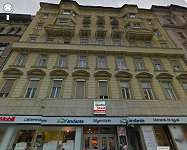
Szent István Boulevard 30 was designated as a yellow-star house so that the Kerpel family could continued operating their 24-hour pharmacy, alongside the curfew imposed on them too. We also lived here with my mother and uncle, until the Arrow Cross concierge directed us to the holding place in Óbuda. We managed to escape from there with the help of a fake Arrow Cross man, who risked his own safety. I thank this unknown person.
2014. July 08., Tuesday

Epilog
On June 21, 2014, we remembered the creation of the Yellow-star Houses, in the Budapest program organized by OSA. Very many people came to Akácfa Street 59, including many Holocaust survivors too: Géza Kertész, Tibor Kalmár, Mrs. Sándor Bihari, Erzsébet Sós and Auntie Feuermann. I raised the question of the "Blumenfeld boy." Many people knew that the family had survived the Holocaust, and stayed living at Akácfa Street 59. They owned the glazier's business that opened onto the street, where today there is a restaurant (whose employees were willing to help organize the commemoration). Sándor Blumenfeld had been a master glazier before 1945, according to archival information. The family later Hungarianized their name to Budai, and left the country in 1956.
During the commemoration, we read excerpts from the memoirs of Ármin Bálint, Miksa Fenyő and Júlia Juhász, and my text that connected them together.
Returning to the last sentence of my text: it is thanks to the "Yellow-Star Houses" program that we finally found out what I hadn't known about the Blumenfeld family, although naturally this is gathering of information is not the program's only theoretical-moral-emotional outcome, but much more than that. I would like to thank the OSA employees once again for the idea, and its realization!
July 8, 2014
Judit Bárdos
volunteer organizer of the Akácfa Street 59 program
2014. July 02., Wednesday
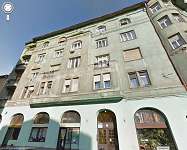
I was born in September 1942, so I don't have much first-hand knowledge.
We lived at Kun Street 12 for a while (having left Karácsony Sándor Street 5 when we had to move into a yellow-star house. My mother's sister, her husband (Pál Weisz) and daughter lived there permanently on the first floor, apartment no. 6.
They told me later that Uncle Pali (who was a very tall man) and the other men from the house were marched out onto the street to be taken away. They stood there lined up for hours, and then for some reason were ordered back into the house, and told to line up on the street again the next day. Since Uncle Pali knew the building well, many men managed to hide in the air shaft of the house. He wasn't willing to hide, since he said he'd be missing from the line-up the next day, and the Arrow Cross would notice since he was so tall. They'd search the whole house until they found everyone in hiding. He too was taken away the next day, and never came back. He had in fact sacrificed himself for those men he had hidden.
His wife, Ilona Hirschler and their daughter Mrs. Lajos Gordon, b. Weisz (or Weiss? I'm not sure), lived there until their deaths. I also lived there between 1950 and 1953, because my parents were in prison for attempting to defect.
My name is Jutka Bednar (born Gross) and I live in Australia.
2014. June 30., Monday
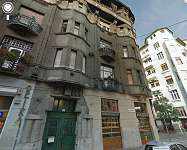
My grandmother Mrs. Imre Datner born Klári Weinberger and her four-year-old daughter Judit (my mother) lived here at Hegedűs Gyula (then Csáky) Street 34 on the fourth floor. My grandmother lived here from June 1944 until she was deported with her siblings to Bergen-Belsen. At the time her husband, Imre Datner, was on forced labor service. By some miracle, Klári, Jutka and Imre survived these horrors and were re-united in 1945. Most of the family however—cousins, parents and children—fell victim to the Holocaust.
2014. June 24., Tuesday
The house is at Dembinszky Street 4, where I lived until 1951. Concerning the history of the house, I only know that until nationalization, it was owned by a Jewish family, which partly survived the Holocaust. I don't remember the family's name, only that they lived on the first floor facing the street. The house had a rear courtyard, where there was a two-story factory that made stockings. The windows of our apartment looked onto this rear courtyard. Later, this factory was also nationalized, and I remember it became a bookbinder's. Thank you for preserving the events of 70 years ago for posterity. Greetings, Mrs. Andor (Judit) Arató.
WHO KNOWS WHAT
1944
The fenced-in ghetto didn't come about right away. First was we were moved in together: the yellow-star houses. We had to sew a yellow star onto our chests (my doll also wore a tiny one, since "she" also belonged to the family), and a larger yellow star was nailed onto the front gate of the house. There's no denying that the authorities had some sort of rationality, since the few Christian families were moved out of the Dembinszky Street house, they were exempt from the Jewish laws. Jewish and mixed-marriage families stayed. And then of course loads of people arrived from elsewhere, there were 20 people crammed into each flat, but for us children this mean new friends to play with and have great fun. You could go out onto the street until 11 a.m. This is when the adults went shopping, and we could buy ice cream when the old ice cream seller on his tricycle rang his bell in front of the house. If he was late by a couple of minutes, the concierge didn't let us out, and always locked the gate. What could the Jews have done in this state of confinement? In the afternoons, they strolled about and argued in the courtyard while we children ran about and made a din. This is how the idea of putting on a cultural show was born. There was great excitement and preparation, everyone wanted to show what they knew best. When the great day arrived, the strict concierge built a platform in the rear courtyard, everyone took chairs downstairs, and even a piano appeared from somewhere. The women ironed their dresses, curling irons clattered, and both performers and audience members put on their best appearances. The adults sang, played music, someone read aloud from a Jókai novel, or recited poems by Ady and Petőfi. Miki F., the teenage rascal, performed a demonic dance in a black mask. The greatest success belonged to Bözsi F., a charming little slip of a girl. She was already a great dancer and it's no surprise that she'd studied with Mr. Lakner at the children's theatre, and today she is an outstanding actress. The author of these lines, then a six-year-old gil, read Emil Ábrányi's poem "Kossuth's grave." The last lines were:
Ott, hol a Szabadság ül isteni székben [There, where Freedom sits in its divine seat]
S tündöklő betűkkel legszebb lapját írja, [Writing his finest page in gleaming letters]
Az a fényes szent hely, az a Kossuth sírja. [That shining holy place is Kossuth's grave.]
It's amazing that there was no air-raid that day, and this was only a few weeks before that day in October when the armed Arrow Cross adolescent lined up the performers and audience in the courtyard, then led them to the brick factory and from there to the wagons, and only very few of them came back.
Mrs Andor Arató, Judit Schönberger
Published in the March 2001 issue of Budai Sófár.
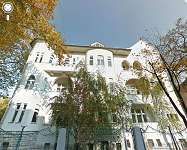
We lived at Cházár András (then Szent Domonkos) Street 2 from 1939 (the building is no longer there today, it was demolished and there’s a housing estate in its place). When the yellow-star houses decree was issued, we had to move from here to the yellow-star house at no. 9 (which is still standing). We ended up in one of the rooms in a large, four-bedroom apartment: my parents, maternal grandmother, my older brother and me. Perhaps all the flats belonged to Jews. Naturally, the apartment’s owner also stayed, Lajos Arató (?) and his family. We got one room.
What I remember from the house: Erzsi Albert was an opera singer and not Jewish, but her husband Rosenberg (?) was … yes, they were distant relatives of ours. There was also a young boy Rónai, the same age as us, he was from Transylvania. I remember long philosophical discussions. We were still living here when leaflets were dropped from high above us, which said that the rural Jews had been taken to Auschwitz. We also received a handwritten postcard that was difficult to read from one of our relatives deported from Nyíracsád, who had handed the postcard over to someone through the Nyíregyháza ghetto fence, and in which they bade us goodbye. Of course the author couldn’t have known where we were, and so addressed the letter to Szent Domonkos Street 2.
The neighboring houses at no. 5 and no. 7 were also yellow-star houses. The courtyards were shared, and so we were in contact with the people in those houses too. This is where the pianist Vera Elfer also was, she was older than me and, in 1956, left for America with the violinist Endre Zathureczky. Vera Elfer’s beautiful recollection about the town where they settled is available online. The graphologist Klára Ács was also here, she wrote a book about how to analyze writing. At no. 5 lived a sculptor, maybe Manó Dick was his name, but I’m not sure.
Ervin Földi, born Fisch in Budapest, 1931.
2014. June 21., Saturday

My paternal grandmother lived here. A few weeks ago I received a letter which had been kept in America for seventy years, it was written by a relative from Cluj, who mentioned that they were taken via Pest to Germany, and this is where they were able to meet my grandmother, into whose apartment two families had been moved. This was never spoken about in the family. At the time, both of her sons were on forced labor service.
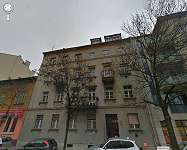
My grandparents, Mór (Mózes) Kramer and his wife, née. Kornélia Engel, moved to the first floor apartment of the house after the birth of their third child, in 1937 or 1938. They were accompanied by their housekeeper, Jusztina Simon, who had been living with them since the birth of their middle child (my mother). This was the place where my grandfather had been summoned to service from, afterwards to be brought to the Eastern frontline; it was also here that my grandmother learned his husband had died of typhus in Usica, Ukraine, on April 15, 1943. (This came to my knowledge only in the winter of 2012, when I discovered the official note on the site of www.hadisir.hu. I will always regret that my mother, having passed away in May 2011, could not get to see this record.)
As the building had become one of the yellow-star houses, Jusztina, a reformed Catholic –nicknamed 'Juckó' and later on, right until her death in November 1975, 'Nagyika' (Hung. for 'Granny')– had to leave the house. However, as long as she could, she fled back and, by bribing the janitress, she smuggled food to the family that already had to share the flat with many other families by that time. Around September that year they had to leave Óbuda. They moved to 6 Ó street, to the parents of my grandmother's; it was from here that my grandmother and his eldest son, György, were taken away. I still own the three postcards she, through some miracle, had managed to send to Juckó – the last one had been written after leaving Dorog. My mother, Vera and her brother, Péter were put into the ghetto of Klauzál place along with their maternal grandparents. By the time the war had ended, my mother and Péter (then 13 and 8 years old, respectively) lost both of their parents and their elder brother. Afterwards, a survivor from Bergen-Belsen came to tell that their mother and brother had died of typhus one month before the camp was liberated: they, then, returned to their old flat as orphans, just to find it almost entirely robbed. (Although their relatives had survived the war, they turned out to be ones of the less benevolent kind.) They were brought up by Juckó, our own 'Nagyika'. It wasn't by coincidence that my grandmother's last letters had been addressed to her; that she had trusted her with taking care of her children. Juckó took care of them, took care of me and my sister – until her death, aged 83. She spent most of her lifetime with my family. She was a good person.
On another note, it was the era of the yellow-star houses that served as a basis for the co-tenancy system lasting until 1968: even I used to know Mrs. Reisz and the Basa family (as to how they had managed to last, I don't know – somehow, it wasn't discussed, or maybe I was too young to comprehend). Practically, my sister and I lived here until getting married in 1980, and my parents stayed until 1981. We all went into different directions, then all came back to Óbuda – I, myself, to the 'Fischer' house.
The only person alive from Mór Kramer's family is my uncle, residing in New York, with his children and grandchildren.
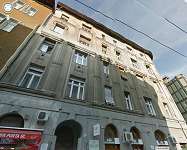
I lived in this house since my birth in 1947 until 1968, but never knew it was a yellow-star house. My parents moved in in 1937, and according to the document attached, the Pension Fund bought the house in 1943. All I know about the entire period is that my Father was on forced labor service, and my mother and five-year-old brother had to leave the apartment, but when they returned, they found everything in its place. Once they were taken to the Tattersaal, and my brother had blond curls, which the Arrow Cross lad escort must have taken to hear, because he let them go. They survived the final period somewhere in a protected house, but unfortunately I don’t know where, and there’s nobody left to ask. There was a patisserie at Wesselényi Street 60 run by the Csákányi family, who lived on the third floor. I remember my mother told me that Uncle Csákányi was the air-raid shelter warden, and was very kind.